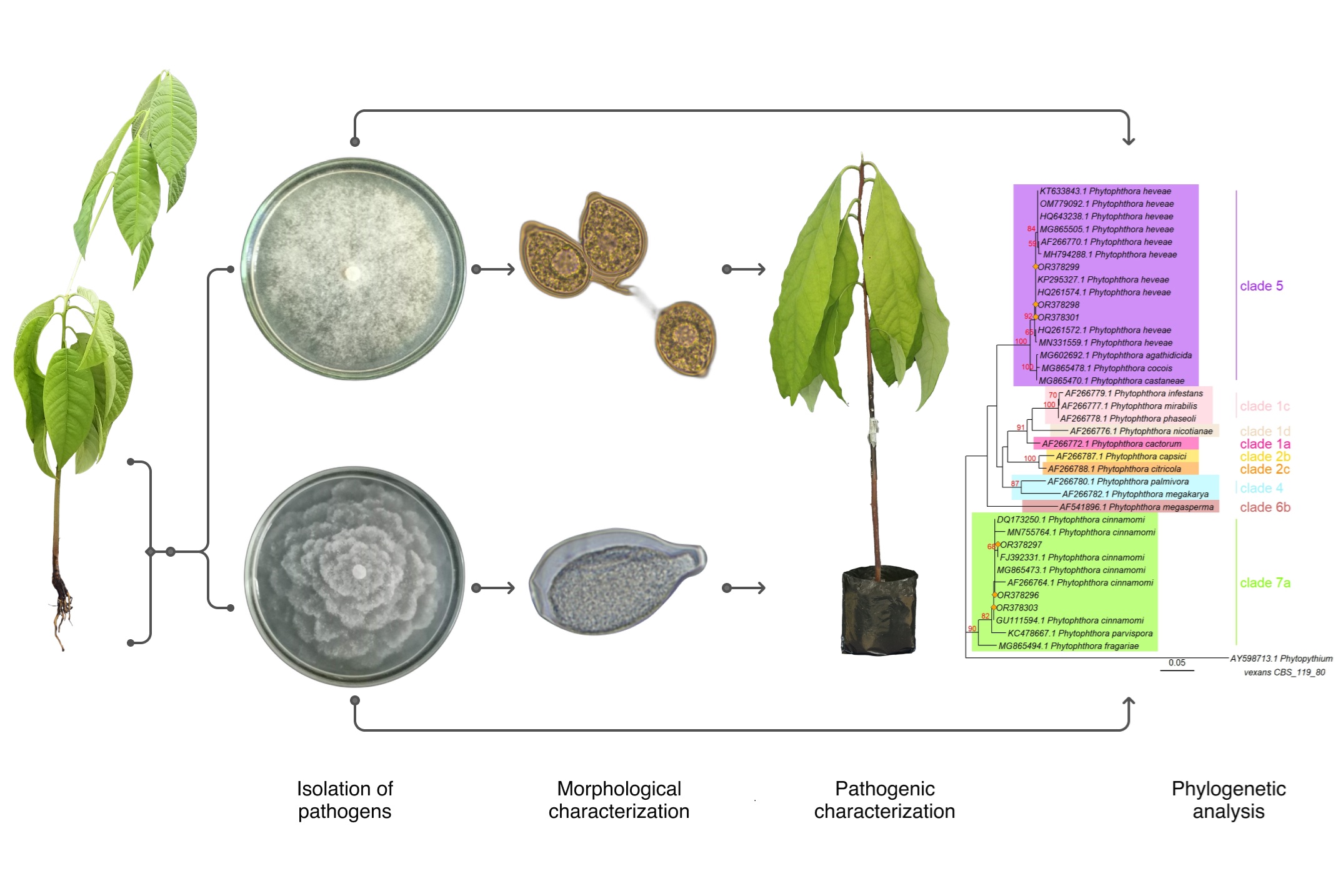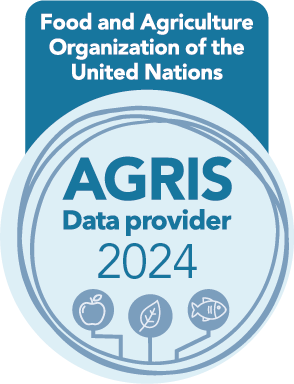Phytophthora species causing root rot in avocado seedlings at Colombian nurseries: Morphological, molecular, and pathogenic analysis
DOI:
https://doi.org/10.17268/sci.agropecu.2025.010Palavras-chave:
PCR, Phytophthora cinnamomi, P. heveae, Persea americana, wiltingResumo
Expansion of avocado production areas in Colombia has led to an increased demand for plant propagation material. However, this expansion has exacerbated phytosanitary challenges, particularly root rot disease mainly associated with Phytophthora spp. Therefore, this study aimed to identify Phytophthora species associated with root rot in avocado seedlings within nurseries. Avocado plants exhibiting wilting symptoms were collected from nurseries in the departments of Quindío, Risaralda, and Valle del Cauca (Colombia). Segments of diseased roots were selected, cut, and surface-disinfected, before being planted on Potato Dextrose Agar (PDA) supplemented with antibiotics and fungicides. Microorganism identification was conducted using taxonomic keys and confirmed by molecular techniques employing the identification based on phylogenetic hypothesis, using ITS1-5.8s-ITS2 region encoding for rRNA. Isolates obtained from necrotic avocado roots were identified as P. cinnamomi and P. heveae. The pathogenicity of the isolates was confirmed in avocado seedlings through inoculation, resulting in symptom reproduction. Consequently, this study identified P. cinnamomi and P. heveae as causal agents of root rot in avocado during the nursery stage.
Referências
Abad, Z. G., Burgess, T., Redford, A. J., Bienapfl, J. C., Mathew, R., et al., (2023). IDphy: An international online resource for molecular and morphological identification of Phytophthora. Plant Disease, 107(4), 987–998. https://doi.org/10.1094/pdis-02-22-0448-fe
Agapito, E. M., Cibrián-Llanderal, V. D., Gutiérrez, M., Ruiz-Juárez, D., López-Corona, B. E. et al. (2022). Phytophthora cinnamomi Rands in avocado. Revista Mexicana de Ciencias Agrícolas, 13(28), 331–341. https://doi.org/10.29312/remexca.v13i28.3287
Álvarez, A., Oliveros, D., Ávila, Y. C., Sabogal-Palma, A. C., Murillo, W., et al. (2023). Resistance induction with silicon in Hass avocado plants inoculated with Phytophthora cinnamomi Rands. Plant Signaling & Behavior, 18(1), 1-11. https://doi.org/10.1080/15592324.2023.2178362
Ángel-García, C.; Rodríguez-Arevalo, K. A.; Murcia Riaño, N.; Martínez-Caballero, L. N.; Ceballos-Aguirre, G., et al. (2023). Molecular identification and fungal diversity associated with diseases in Hass avocado fruit grown in Cauca, Colombia. Pathogens, 12(12), 1418. https://doi.org/10.3390/pathogens12121418
Belisle, R. J., Mckee, B., Hao, W., Crowley, M., Arpaia, M. L., et al. (2019). Phenotypic characterization of genetically distinct Phytophthora cinnamomi isolates from avocado. Phytopathology, 109(3), 384–394. https://doi.org/10.1094/PHYTO-09-17-0326-R
Castaño, Z. J., & Leal, J. M. (2018). Manejo integrado de la pudrición de raíces del aguacate (Persea americana Miller), causada por Phytophthora cinnamomi Rands. Temas Agrarios, 23(2), 131-143. https://doi.org/10.21897/rta.v23i2.1297
Ceja-Torres, L. F., Téliz-Ortiz, D., Osada-Kawasoe, S., & Morales-García, J. L. (2000). Etiología, distribución e incidencia del Cancro del aguacate Persea americana Mill. en cuatro municipios del Estado de Michoacán, México. Revista Mexicana de Fitopatología, 18, 79-86.
Dixon, K. W. T., & Sivasithamparam, K. (1984). Technique for rapid assessment of tolerance of Banksia spp. to root rot caused by Phytophthora cinnamomi. Plant Disease, 68, 1077-1080.
European and Mediterranean Plant Protection Organization (EPPO). (2004). Phytophthora cinnamomi. Diagnostic protocols for regulated pests. European and Mediterranean Plant Protection Organization. Bulletin. https://doi.org/10.1111/j.1365-2338.2004.00720.x. Access on: April 28, 2024.
FAOSTAT. Crops and livestock products. Available at: < https://www.fao.org/faostat/en/#data/QCL >. Accessed on: Feb. 23, 2024.
Lanete, P. J. C., Tendenilla, S. L. S., Trinidad, M. S. L. R., & Bennett, R. M. (2023). An insight into the genus Phytophthora (Peronosporaceae: Oomycota). Philippine Journal of Systematic Biology, 17(1),9-15.
Leal, J., Castaño-Zapata, J., & Bolaños, M. (2014). Manejo de la Pudrición radical (Phytophthora cinnamomi Rands) del aguacate (Persea americana Linneo). Revista U.D.C.A Actualidad & Divulgación Científica, 17(1),105-114. https://doi.org/10.31910/rudca.v17.n1.2014.945
Marulanda, C. (2018). Identificación de aislamientos de Phytophthora cinnamomi asociados al cultivo de aguacate en el sur occidente de Colombia. Thesis (M.sc) - Facultad de Ciencias Agropecuaria, Universidad Nacional de Colombia, Palmira.
Miyambo, T. M., Backer, R., Engelbrecht, J., Joubert, F., & Van Der Merwe, N. A., (2022). The identification and characterization of endopolygalacturonases in a South African isolate of Phytophthora cinnamomi. Microorganisms, 10(5), 1061. https://doi.org/10.3390/microorganisms10051061
Kavroulakis, N., Tziros, G., Mikalef, L., & Malandrakis, A. (2024). First Report of Phytophthora cinnamomi causing root rot of avocado trees in Greece. Plant Disease. doi: 10.1094/PDIS-05-24-0939-PDN
Ochoa-Ascencio, S., Santacruz-Ulibarri, H., & Salazar-García, S. (2011). Phytophthora heveae causing basal rot of avocado fruit in México. En: VII World Avocado Congress, Cairns, Australia, Proceedings.
Ochoa-Fuentes, Y. M., Cerna-Chávez, E., Gallegos-Morales, G., Cepeda-Siller, M., Landeros-Flores, J., et al. (2015). Variabilidad patogénica de Phytophthora cinnamomi Rands en Persea americana Mill. de Michoacán, México. Ecosistemas y recursos agropecuarios, 2(5), 211-215.
Parkinson, L. E., Shivas, R. G., & Dann, E. K. (2017). Pathogenicity of nectriaceous fungi on avocado in Australia. Phytopathology, 107(12), 1479–1485. https://doi.org/10.1094/PHYTO-03-17-0084-R
Raeder, U., & Broda, P. (1985). Rapid preparation of DNA from filamentous fungi. Letters in Applied Microbiology, 1, 17–20. https://doi.org/10.1111/j.1472-765X.1985.tb01479.x
Ramírez-Gil, J., Castañeda, D., & Morales, O. (2014). Estudios etiológicos de la marchitez del aguacate en Antioquia-Colombia. Revista Ceres, 61(1), 50–61. https://doi.org/10.1590/S0034-737X2014000100007
Ramírez-Gil, J., Gilchrist, R., & Morales, O. (2017). Economic impact of the avocado (cv. Hass) wilt disease complex in Antioquia, Colombia, crops under different technological management levels. Crop Protection, 101, 103–115. https://doi.org/10.1016/j.cropro.2017.07.023
Ramírez-Gil, J. (2018). Avocado wilt complex disease, implications and management in Colombia. Revista Facultad Nacional de Agronomía Medellín, 71(2), 8525–8541. https://doi.org/10.15446/rfna.v71n2.66465
Ramírez-Gil, J., & Morales, O. (2020). Development and validation of severity scales of avocado wilt complex caused by Phytophthora cinnamomi, Verticillium dahliae and hypoxia-anoxia disorder and their physiological responses in avocado plants. Agronomía Colombiana, 38(1), 85-100. https://doi.org/10.15446/agron.colomb.v38n1.78527
Saltarén, L. F., Varón De Agudelo, F., & Marmolejo, F. (1998). Patógenos radicales en material de propagación de aguacate (Persea americana Mill.). Fitopatología Colombiana, 22(2), 52-58.
Tsao, P. H., & Guy, S. (1983). Factors affecting isolation and quantitation of Phytophthora from soil. In Erwin, C., Barnicki-Garcia, S., Tsao, P. H. (Eds.) Phytophthora: Its Biology, Taxonomy, Ecology and Pathology (pp. 219-235). American Phytopathological Society Press.
Villarino, M., Larena, I., Melgarejo P., & De Cal, A. (2021). Effect of chemical alternatives to methyl bromide on soil‐borne disease incidence and fungal populations in Spanish strawberry nurseries: A long‐term study. Pest Management Science, 77(2),766-774. https://doi.org/10.1002/ps.6077
White, T. J., Burns, T., Lee, S., & Taylos, J. (1990). Amplification and Direct Sequencing of Fungal Ribosomal RNA Genes for Phylogenetics. In M. Innis, D. Gelfand, J. Sninsky, & T. White (Eds.), PCR Protocols: A Guide to Methods and Applications (pp. 315–322). Academic Press.
Zentmyer, G. A., Klure, L. J., & Pond, E. C. (1978). A new canker disease of avocado caused by Phytophthora heveae. Plant Disease Reporter, 62, 918-922.

Downloads
Publicado
Como Citar
Edição
Seção
Licença
Copyright (c) 2025 Scientia Agropecuaria

Este trabalho está licenciado sob uma licença Creative Commons Attribution-NonCommercial 4.0 International License.
Los autores que publican en esta revista aceptan los siguientes términos:
a. Los autores conservan los derechos de autor y conceden a la revista el derecho publicación, simultáneamente licenciada bajo una licencia de Creative Commons que permite a otros compartir el trabajo, pero citando la publicación inicial en esta revista.
b. Los autores pueden celebrar acuerdos contractuales adicionales separados para la distribución no exclusiva de la versión publicada de la obra de la revista (por ejemplo, publicarla en un repositorio institucional o publicarla en un libro), pero citando la publicación inicial en esta revista.
c. Se permite y anima a los autores a publicar su trabajo en línea (por ejemplo, en repositorios institucionales o en su sitio web) antes y durante el proceso de presentación, ya que puede conducir a intercambios productivos, así como una mayor citación del trabajo publicado (ver efecto del acceso abierto).




